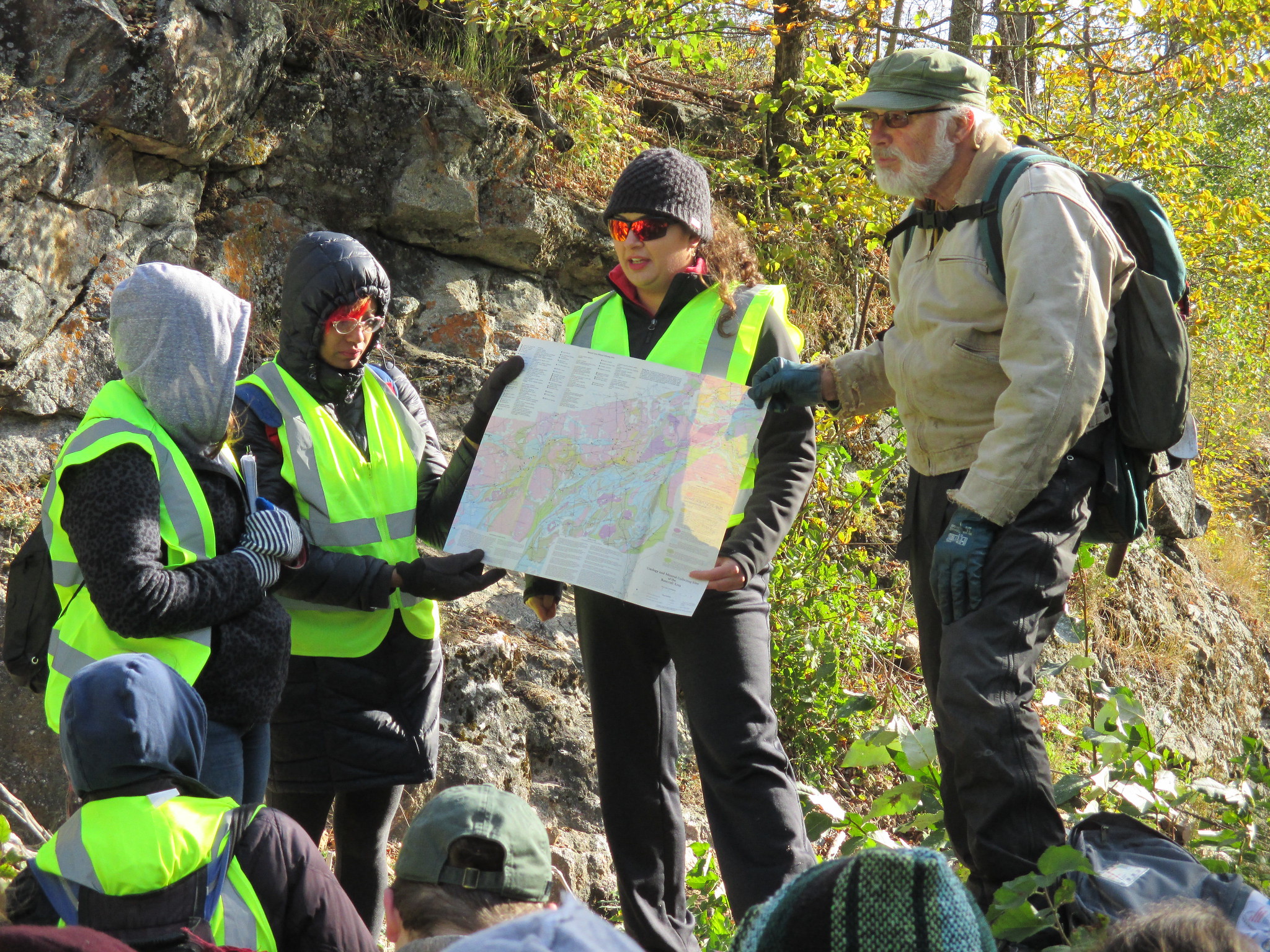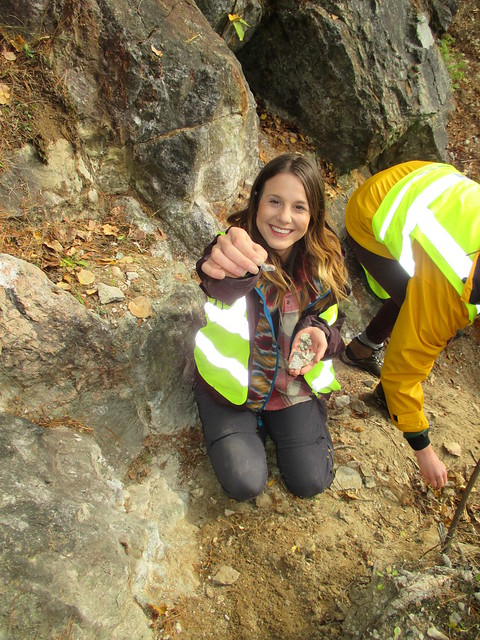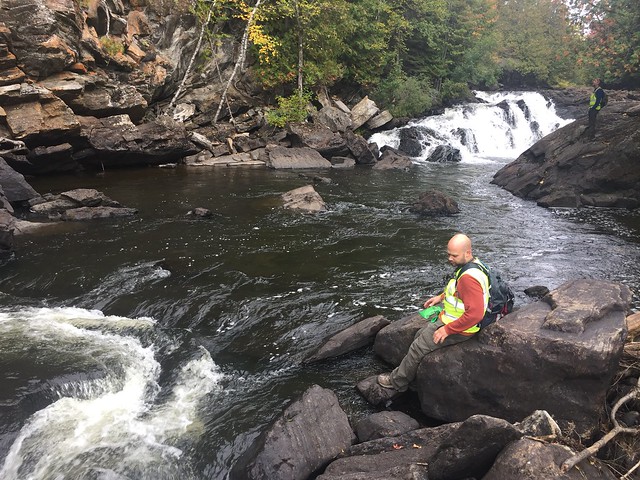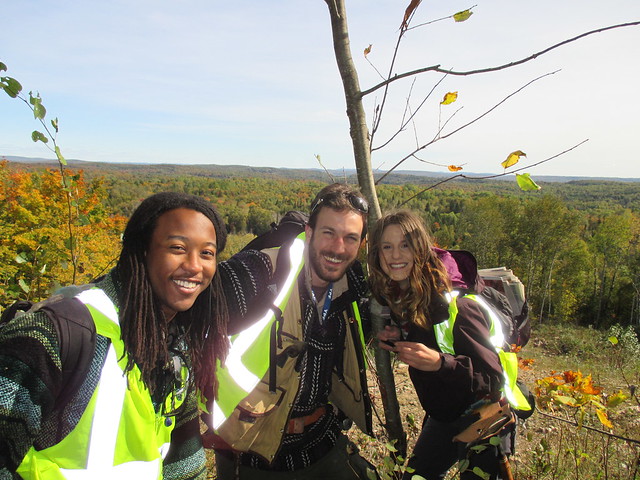Geology rocks: Unearthing treasure in Bancroft
Every year for the past half-century, a group of students and faculty from the Wayne State Department of Geology has ventured 400 miles away from Old Main to Bancroft, Ontario.
 It takes more than eight hours to get there, but that's an insignificant amount of time when your end goal is to investigate minerals that formed over a billion years ago. For four days amidst an ancient geological backdrop, students experience an introduction to mineralogy while uncovering coveted crystals and making valuable connections.
It takes more than eight hours to get there, but that's an insignificant amount of time when your end goal is to investigate minerals that formed over a billion years ago. For four days amidst an ancient geological backdrop, students experience an introduction to mineralogy while uncovering coveted crystals and making valuable connections.
Even after decades of studying minerals, recently retired Department of Geology Academic Services Officer David Lowrie '64 says he has barely scratched the surface of Bancroft. He and best friend David Doherty '72, M.S. '76, an adjunct lecturer who makes up the other half of "the Daves," as they are affectionately called by students and alumni, take undergrads majoring in geology and environmental science to Bancroft each year as part of a required mineralogy course and won't let a little thing like retirement get in the way of their annual adventure.
Students say the Daves make Bancroft an exceptional experience by bringing their trademark humor and knowledge along with essential supplies such as micro blasters, crack hammers and foxhole diggers.
Geology junior Kelsey Hewett, who enjoyed a second visit to Bancroft last year as a teaching assistant, said the Daves impart priceless wisdom to students, recommending where to dig for the best minerals and always making sure the experience is fun and inclusive.
"Almost every trip someone finds an apatite specimen of museum quality there."
In recent years, each expedition has included 50 or more students, most of them sophomores. Hundreds have made the trek because it is a required course, but several students sign up time and again because they love it.
The journey begins on a Thursday in September, when students meet on campus and pile into several vehicles. The caravan crosses the border, drives past Toronto, and then continues northeast into less populated parts of the province. "The highways keep getting smaller and smaller and smaller until you're just on one last road for a very long time," Hewett says.

The travelers pass terrain of sedimentary rocks, glacial features and farmland. During the last 70 miles, they start to see a landscape that is the result of a billion years of erosional history, and what Lowrie describes as "much older rocks, including Precambrian granites, roots of an ancient mountain chain, high rocky ridges, beautiful lakes and heavily wooded forested areas - what can be called metamorphic terrain."
World-class specimens of apatite crystals and radioactive minerals, including uraninite, Betafite and radioactive zircon, often are found and taken back home by the travelers for their own collections. A staple of geology textbooks, Bancroft features more than 200 different species of minerals, many of them in crystal for, much to collector's delight.
Benjamin Mark '17 has been to Bancroft 15 times in the past three years and is astounded by the sheer variety of minerals found in the region. "I think it's something like 80 to 90 percent of all the known minerals can be found within a 100- mile radius of Bancroft," he says. "And you can find a few minerals there that you won't find anywhere else."
On the Wayne State field trip, the carpooling students and the Daves communicate by radio to talk about passing scenery - mostly trees but sometimes moose and bears roaming the roadside. When the geologists have exhausted every road trip chat and game and finally reach their destination, they look upon what Hewett describes as cotton candy clouds floating across the skies above Baptiste Lake. Evergreen-laden hills surround its secluded waters, which reach depths of 120 feet, and the wind gently sweeps small waves toward shore, where the Birch Cliff Lodge stands. This is where classmates sleep, gather around board games, play the piano and work together to prepare hot meals between excursions.
Long-lasting friendships and sometimes even romances develop. "On the first night, we had a big bonfire. It was just really nice to get to know everybody," Hewett says of her initial visit. "By the end of that trip, everyone was best friends."
Junior Ben Gaskevicius officially declared geology as his major after going on the Bancroft trip. He recalls the lakeside area as peaceful and leisurely: "I enjoyed canoeing in Baptiste Lake and watching the sun set over Birch Cliff Lodge, trying to stay warm in a hammock I had set up with a few other students on the beach, and sitting by the quiet and cool waters of the lake late at night."
Geology junior Max Denny says the 2016 trip made him feel at home. "Even though I loved the subject, I hadn't really felt a connection to the community," Denny says. "When I went to Bancroft, that completely changed. Being in such an amazing place geologically as a group, I was not just a weird kid who liked rocks anymore - I was with a group of people who liked rocks."

Field notes
As the Daves have aged, they've revised the logistics. In the early years, trips took place in the spring, when black flies, mosquitos and no-see-ums were more prevalent. Students used to sleep in tents, braving the Canadian cold.
Kathleen Aseltyne '78, '84, M.S. '90 recalls it all: "My best memories of the field trip were of Dave Lowrie rousting us from our tents in the freezing cold mornings, announcing cheerily at sunrise, 'Time to get up; there is frost on the pumpkins.' We hated it."
Students these days aren't enduring those conditions but the payoff is the same. One outing has them hiking to the York River, walking through the woods along the riverbank, where waters cascade through a narrow gorge. Reddish rock formations loom behind them, splashed by water rhythmically crashing up off the rapids. The group then enjoys an elevated view of the region at Eagle's Nest.
"I remember sitting on a bench with the other students on the wooden perch of the outlook at Eagle's Nest. As the Daves stretched out a map to tell us about the geologic history of the area, I remember thinking how real and genuine that experience was," Gaskevicius says. "I thought to myself, 'This is why I want to be a geologist.'"
The trip becomes a real blast when students visit the Princess Sodalite Mine, which is privately owned but accessible to Wayne State students due to a friendship the Daves have with the owner. There, Lowrie utilizes a powerful micro blaster device to break up grey rock containing the famously unique blue mineral, sodalite. One of the locals takes a sledgehammer to parts of the rock for the students to see.
The Daves impart priceless wisdom to students, recommending where to dig for the best minerals and always making sure the experience is fun and inclusive.
The mine is 30 to 40 feet deep but contains an even deeper history. For a time it was owned by the Crown, and when the property opened in 1906, the prince and princess of Wales (King George V and Queen Mary) visited and then had 130 tons of sodalite shipped overseas to decorate Marlborough House in London.
Lowrie says the most exciting part of the whole trip comes on the final day when they visit Millar's Mine, where students search for Jolly Rancher green apatite crystals. Lowrie says their desire for apatite whets their appetite for mineralogy.
"Almost every trip, someone finds an apatite specimen of museum quality there," Lowrie says.
Historically, the area included deep geological veins where crystals and sometimes trees had grown in, projecting into the cavities. Over many years, the veins filled in with calcite. As time passed, the calcium carbonite was dissolved by weak organic acids and the crystals were left exposed or loose in the bottom of these veins, which can be up to hundreds of feet long. There, minerals perfect for collecting can be found.
Arriving at the site, the Daves and their teaching assistants provide tools and instructions and give students a few hours of freedom to search for minerals on their own.
"Some students would find something right off the bat and be happy about it, so it would make you want to find something too," Hewett says. "So you would dig extra hard in the dirt, between rocks, cracking stuff open."
She learned just how delicate the ancient apatite can be.
"I found one, 3 to 3.5 inches, put it in the chest pocket of my jacket, got back to the car, went to go pull it out, and it turned into dust crumbles," she says, adding that a crystal that size would be considered quite a find, but that some students have  unearthed even larger specimens.
unearthed even larger specimens.
Geology junior Regan Brandt says the field trip is an especially nice bonding experience for students who live off campus. On her first trip to Bancroft, she met her boyfriend.
Then the next year as a teaching assistant, she found an unforgettable apatite while hammering away alongside students for another more common mineral called hornblende in a six-foot crevice in the mine.
"It was so dark and deep, I couldn't see anything at this point. I felt something shift in the corner but I wasn't able to get in underneath the shelf so I pulled it out with the end of the hammer," Brandt says. "I thought I would toss away a piece of calcite, but it was an 8- to 10-inch piece of Jolly Rancher green apatite. I screamed and we all celebrated!"
Gaskevicius has also celebrated at the apatite mine, though his discovery came a bit easier
"I happened to walk by a piece of rock covered in crystals, which somebody long ago had likely slung to the side in search of better specimens. I remember showing it to Mr. Lowrie, who must have seen the blood, sweat and tears on me and assumed I dug hard for it. I didn't tell him that all I had to do was pick it up off the ground," Gaskevicius says.
Bancroft often is a place of reflection for students. "It's crazy to look at something so old and think about what Earth must have been like when that rock formed," says Benjamin Mark.
"It would have been totally unrecognizable from what we know today. It's also cool to look at ancient mountains and think that they were there back when the first life walked on land they were there when the dinosaurs walked the earth, and even back then they were ancient."
Digging for long-covered minerals in Bancroft reminds students that life is short, and inspires them to spend their own time on Earth following their passions.
"As humans, we hope to live 100 years, and 100 years out of 4.5 billion is not even a blink of an eye," Hewett says. "It puts it into perspective that we are just a very, very small part of a huge historical story."
This story originally appeared in the Spring 2019 Wayne State Alumni Magazine.